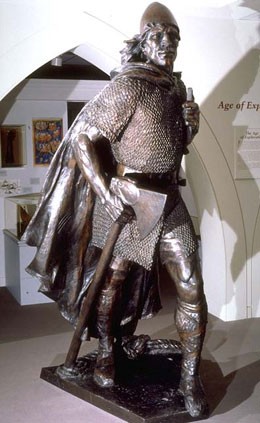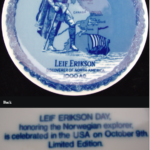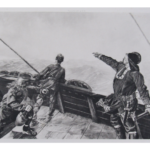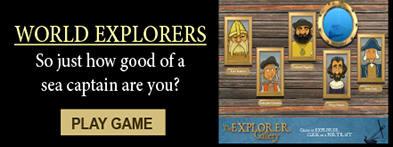Leif Eriksson
Explorer
Medieval
Quick Facts:
He became the first European to land on and establish a settlement in North America. He is also credited for bringing Christianity to Greenland.
Introduction
Nearly 500 years before Christopher Columbus crossed the ocean blue, a Norse Viking by the name of Leif Eriksson landed on the North American continent. Eriksson is believed to be the first European to have landed on and established a settlement in North America around 1000 CE. Today, we still ask ourselves, “Who really discovered America?”
Biography
Early Life
Leif Eriksson (also spelled Ericson) was born in Iceland around 970 CE. He would eventually earn the nickname “Leif the Lucky.” He was the son of Erik Thorvaldson, better known as “Erik the Red,” and Thorhild. In Viking tradition, children are named after their father. When Erik the Red had a son and named him Leif, he became Leif Eriksson (Leif, Erik’s son).1 He had two brothers, Thorvald, and Thorstein; and a sister named Freydis. One cannot tell Leif’s story without first knowing his father’s journeys. As a small boy, Leif grew up without his father who had been banished from Iceland after being found guilty of murder. Erik was gone for three years, during which time he discovered and explored Greenland. When Erik returned to Iceland, he told the people of the new country he’d found. Erik took his family and several other colonists, and established a new home in Greenland where Leif grew up in a place called Brattahlid.
In Greenland, Erik was elected the people’s leader, which did not leave much time for him to pay attention to Leif. So Leif was mostly taught and raised by one of Erik’s followers, a man named Tyrker.2 In 1000 CE, Leif traveled to Norway where he spent the winter in the house of King Olaf Tryggvason, who was a Christian. Here, Leif converted to the Christian religion. He eventually returned to Greenland where he converted many colonists to Christianity as well. Back in Greenland, Erik the Red was told by a fellow Viking of a rich land to the west he’d seen when he was blown off course during his voyage to Greenland. Erik and Leif planned to go explore this new land. However, Erik’s horse stumbled before they were getting ready to leave. He took this as an omen that he should stay home, which left Leif to lead the adventurous voyage.
Voyages
Principal Voyage
Around 1000 CE, Leif Eriksson purchased a ship from a fellow Norseman, gathered a crew of 35 men, and set sail for the new lands. Much of what they first explored is believed to be part of present day northern Canada, although it is not known for sure.3 They first landed in an area that was flat and covered in rocks and glaciers. Eriksson named this region Helluland, meaning “Land of Flat Rocks.” Helluland is believed to be modern day Baffin Island.4 This bare area of rocks had no use of a potential Norse colony, so Leif continued onward. Moving south along the coast, Eriksson and his crew reached what is believed to be present day Labrador. This area was covered in trees and white sands, so Eriksson named it Markland, or “Forest Land.”
They continued further south until they came to an island. They went ashore and found the area to be green with trees that had sweet wild grapes. Eriksson and his crew built houses and spent winter in this area which he named Vinland or “Wineland.”5 While on shore, they found an abundance of salmon for food, and that the grass would be good for cattle. Leif divided his crew: half would stay with houses and do work; the other half would further explore the land. To be fair, Leif would sometimes stay to help with the work and other times go exploring. At one point, Leif’s foster father Tyrker, who was part of Leif’s crew, found an area thriving with grapevines. They collected several vines and grapes to be taken back home with them.6 The next spring, they set sail for Greenland.
Subsequent Voyages
Leif loaded his ship with the grapes and vines they had found, and set sail back to Greenland. They had fair wind their entire journey, and the trip was fairly uneventful. At one point, however, during the return trip home, Leif came upon a shipwreck and stranded crewman. Leif took the fifteen men on board his ship, and brought the rescued men back to Greenland with him. The men eventually found homes and settled there. Eriksson was welcomed home as a hero. He then earned the nickname “Leif the Lucky.”
Later Years and Death
Leif Eriksson never returned to the lands of North America but his brother Thorvald did. Eriksson spent the remainder of his life in Greenland where he spread Christianity to the people. He assumed leadership of the settlements after his father’s death until his own passing. The exact date of Eriksson’s death is unknown, but is estimated around 1020 CE.7
Legacy
Most of what we know of Leif’s life comes from stories known as sagas. These sagas began as oral stories that were told through the generations, and then eventually written down. The Vikings did not manage to establish any permanent settlements in North America. However, Eriksson voyaged to North American lands nearly five centuries before Christopher Columbus did. October 9th is “Leif Eriksson Day.” It was created by US President Lyndon B. Johnson in 1964 to honor and recognize Eriksson’s Nordic heritage’s contributions to American history.
Endnotes
- Don Young and Marjorie Young, Iceland Adventure Guide (Edison: Hunter Publishing, Inc., 2008), 4.
- Peter Archer, The Book of Viking Myths (Avon: Adams Media, 2017), 25.
- Britannica Educational Publishing, Biographies of the New World: Leif Eriksson, Henry Hudson, Charles Darwin, and More, ed. Michael Anderson (New York: Britannica Educational Publishing, 2013), 14.
- “The Saga of the Greenlanders (Grœnlendinga saga),” accessed June 13, 2017, https://notendur.hi.is/haukurth/utgafa/greenlanders.html.
- Britannica Educational Publishing, Biographies of the New World, 14.
- Meriden Scientific Association, Proceedings and Transactions of the Scientific Association, Volumes 4 – 8 (Meriden: Press of E.A. Horton & Co., 1891), 75
- William J. Mills, Exploring Polar Frontiers: A Historical Encyclopedia, Volume 1, A – L (Santa Barbara: ABC – CLIO, 2003), 219.
Bibliography
Archer, Peter. The Book of Viking Myths. Avon: Adams Media, 2017.
Britannica Educational Publishing. Biographies of the New World: Leif Eriksson, Henry Hudson, Charles Darwin, and More. edited by Michael Anderson. New York: Britannica Educational Publishing, 2013.
Meriden Scientific Association. Proceedings and Transactions of the Scientific Association, Volumes 4 – 8. Meriden: Press of E.A. Horton & Co., 1891.
Mills, William J. Exploring Polar Frontiers: A Historical Encyclopedia, Volume 1, A – L. Santa Barbara: ABC – CLIO, 2003.
“The Saga of the Greenlanders (Grœnlendinga saga).” Accessed June 13, 2017. https://notendur.hi.is/haukurth/utgafa/greenlanders.html.
Young, Don and Marjorie Young. Iceland Adventure Guide. Edison: Hunter Publishing, Inc., 2008.
Gallery






